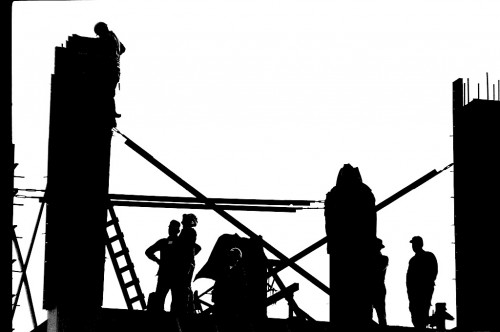 I got a lot of mileage out of a roll of film. The photos of the Notre Dame vs Central High School basketball game took up about half of it.
I got a lot of mileage out of a roll of film. The photos of the Notre Dame vs Central High School basketball game took up about half of it.
This photo, shot on the same roll, ran on the front page of The Missourian February 1, 1967, over the caption, “Pattern in the Sky: Workmen and structural features form an interesting and eye-catching picture in silhouette as the men go about their tasks in the construction of the addition to Kent Library on the State College campus. Open weather during winter months has enabled construction to move along at a rapid pace. McCarthy Construction Co. of St. Louis is prime contractor for the job. Contracts total $2,659,079, with additional funds available for equipping and furnishing the addition. The original Kent Library, named for Miss Sadie T. Kent, longtime librarian at the college, was constructed in 1939.”
This is what we used to call “wild art” or CLO for Cutlines Only. It was a news-oriented feature photo that ran without a story. I probably shot it on the way to or on the way back from a class. Click on any photo to make it larger.
Kent Library construction workers
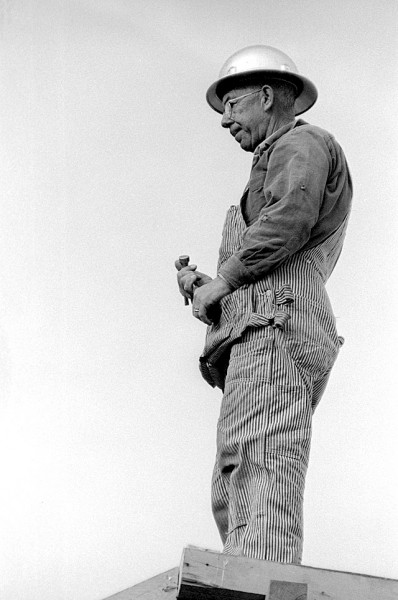 Truth be told, the silhouette was a little too cluttered to be a good photo. I think I shot it as a silhouette because I wasn’t sure the photos I took of workmen on the building could hold enough detail against the bright sky. As it turns out, I like a couple of these better than the silhouette.
Truth be told, the silhouette was a little too cluttered to be a good photo. I think I shot it as a silhouette because I wasn’t sure the photos I took of workmen on the building could hold enough detail against the bright sky. As it turns out, I like a couple of these better than the silhouette.
I like the way he’s gripping his hammer, the couple of small rips in his shirt and the wrinkles in his face that show years of working out in the sun.
From an editor’s perspective, though, it doesn’t tell the story in one shot. It would only work if you ran multiple photos as a mini picture story. That, of course, was the method behind my madness. I was paid by the picture, so it was in my best interest to try to sell a combo package of pictures and hold back the all-in-one shot as a fall-back.
These guys built this country
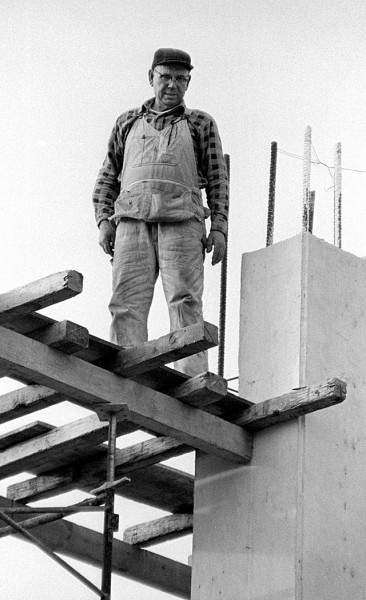 None of these guys ever got rich, but the monuments they built will live long after they are gone.
None of these guys ever got rich, but the monuments they built will live long after they are gone.
Pre-OSHA days
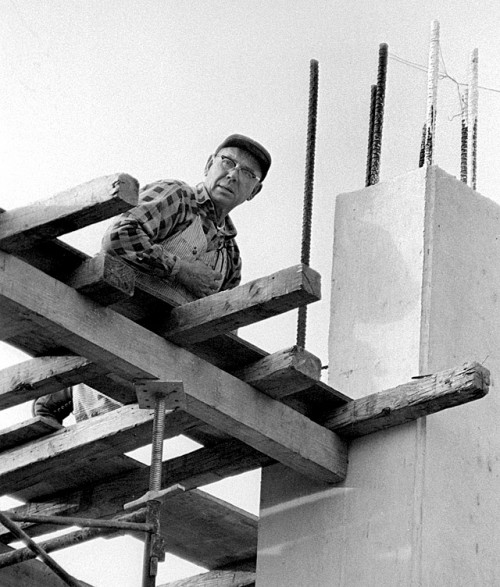 OSHA folks would get cranky these days over rebar without safety caps, scaffolding without guardrails and workers without hard hats and other safety equipment. That’s not to say those aren’t good things. Those pesky regulations were enacted to make a dangerous job just a little bit safer. Construction work exacts enough of a toll on its human engines without adding in accidents.
OSHA folks would get cranky these days over rebar without safety caps, scaffolding without guardrails and workers without hard hats and other safety equipment. That’s not to say those aren’t good things. Those pesky regulations were enacted to make a dangerous job just a little bit safer. Construction work exacts enough of a toll on its human engines without adding in accidents.
Other Kent Library pictures
- 1967 construction
- Kent Library interior circa 1966
- Aerial photos of Kent Library and SEMO campus
- 1966 aerial photos of SEMO campus
What in the world is happening?
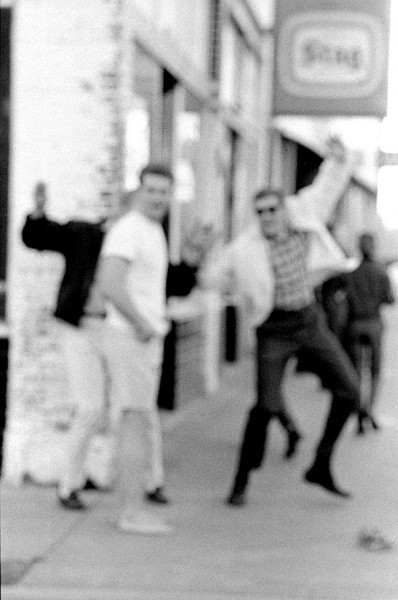 OK, not every photo works. I have no idea who these folks are, what they were doing or why I pushed the button. I didn’t have time to focus and I only got one frame off. They’re not paying any attention to me, so whatever they’re reacting to is down the street.
OK, not every photo works. I have no idea who these folks are, what they were doing or why I pushed the button. I didn’t have time to focus and I only got one frame off. They’re not paying any attention to me, so whatever they’re reacting to is down the street.
It has the feel of Water Street about it, maybe down around the Sportsmans Club.
Another single shot mystery
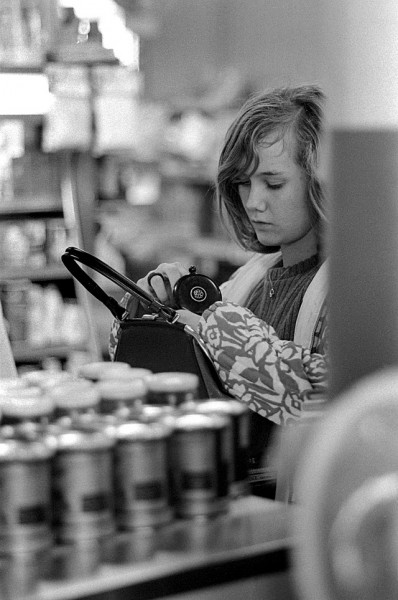 Here’s another single frame. A young woman reaches past her compact to dig for money to buy something. I don’t know she is, where she was or why she caught my eye enough for one frame, but not to follow up with more pictures.
Here’s another single frame. A young woman reaches past her compact to dig for money to buy something. I don’t know she is, where she was or why she caught my eye enough for one frame, but not to follow up with more pictures.
So, that’s a lot of mileage out of one roll: a basketball game, a construction site, some wild and crazy guys on the street and a woman shopping. Toss in a car wreck, a service club meeting and a school feature and it would have been a regular old day as a newspaper photographer in a small town.

The Stag sign in the fifth shot makes me think it was further up Broadway around the old Paladium bar.
You have written the story of a photo-journalist in the most poignant and arresting pictures. What a gift you have.
Picture outside the bar–Was it on the corner of Pacific and Broadway(Southeast corner)?
The girl in the picture looks like Joy Haman Baker, class of something in the 70s
Keep up the good work, Ken
Frony once answered my question of why some people called him One Shot. “Because I had to buy my own film.” So Ken, did you buy your own film, or did you just get better with experience?
Here is a much older photo of Kent Library by Frony:
http://www.semissourian.com/blogs/flynch/entry/33190
I was considered a freelancer in my Missourian days, so I had to provide my own supplies.
To save money, I’d buy film in 100-foot rolls, cut it to 34 exposures and load it into film cans (all in pitch dark).
There are still two thumbtacks on a shelf under the basement stairway at my mother’s house that I used to measure out how long the strip should be.
One of the things that’s driving me crazy now is that I’ll be scanning a roll of my old pictures, see a single frame of what could have been a great situation, and realize that that’s all I shot of it.
There were two big limiting factors in how much film I shot: cost and how many rolls would fit in the developing tank in one run. That tended me make me think in terms of two, four or eight rolls.
Then, too, I had a pretty good idea what I could convince jblue to run. There wasn’t a whole lot of use in shooting two rolls if I knew the situation was going to end up with one published photo.
Thanks for the links, by the way.
Such skill with thumb tacks! I used a film loader for bulk Tri-X and counted the clicks for 36-37 frames. Film was cheap that way, unlike Frony’s 4×5 film sheets. When I started at the Missourian I gave him short rolls of 12 or so, and he would still have unused frames. I guess by then he had been shooting 35mm for a decade or so.
I never liked short rolls. You burned up film with the end that was taped down and you lost more film with the leader at the front. Plus, it took more chemistry to process three 12-exposure rolls than one 36-exposure one.
I didn’t use film loaders for years because I was paranoid about scratching the film. In the early days, film cassettes could be taken apart. The good news was that you could reload them by hand. The bad news was that dropping them could cause them to fly apart, exposing the film.
When they started coming “staked on,” we would make sure we stopped shooting a couple of frames from the end so we could leave about 1-1/2 inches of film sticking out of the can to tape the raw film to.
We used factory-loaded film at The Gastonia Gazette, so when I moved to The Post in West Palm Beach, I asked my former staffers to save their used cassettes until they got a big box full, then they’d ship them to me for reuse.
In later years, I’d allocate each shooter a “brick” – 20-rolls – of factory load every month to keep seeding their stash of cassettes. We loaded color film for a few years, but I transitioned to factory load for it.
We tended to cut our rolls short because we used “dip ‘n’ dunk” film processors. If a roll was too long, it would drag when it was transported from one chemical to the next and either jam up or fall off in the tank. That was A Bad Thing.
Jim, my first thought of the girl was Joy Haman Baker, too!